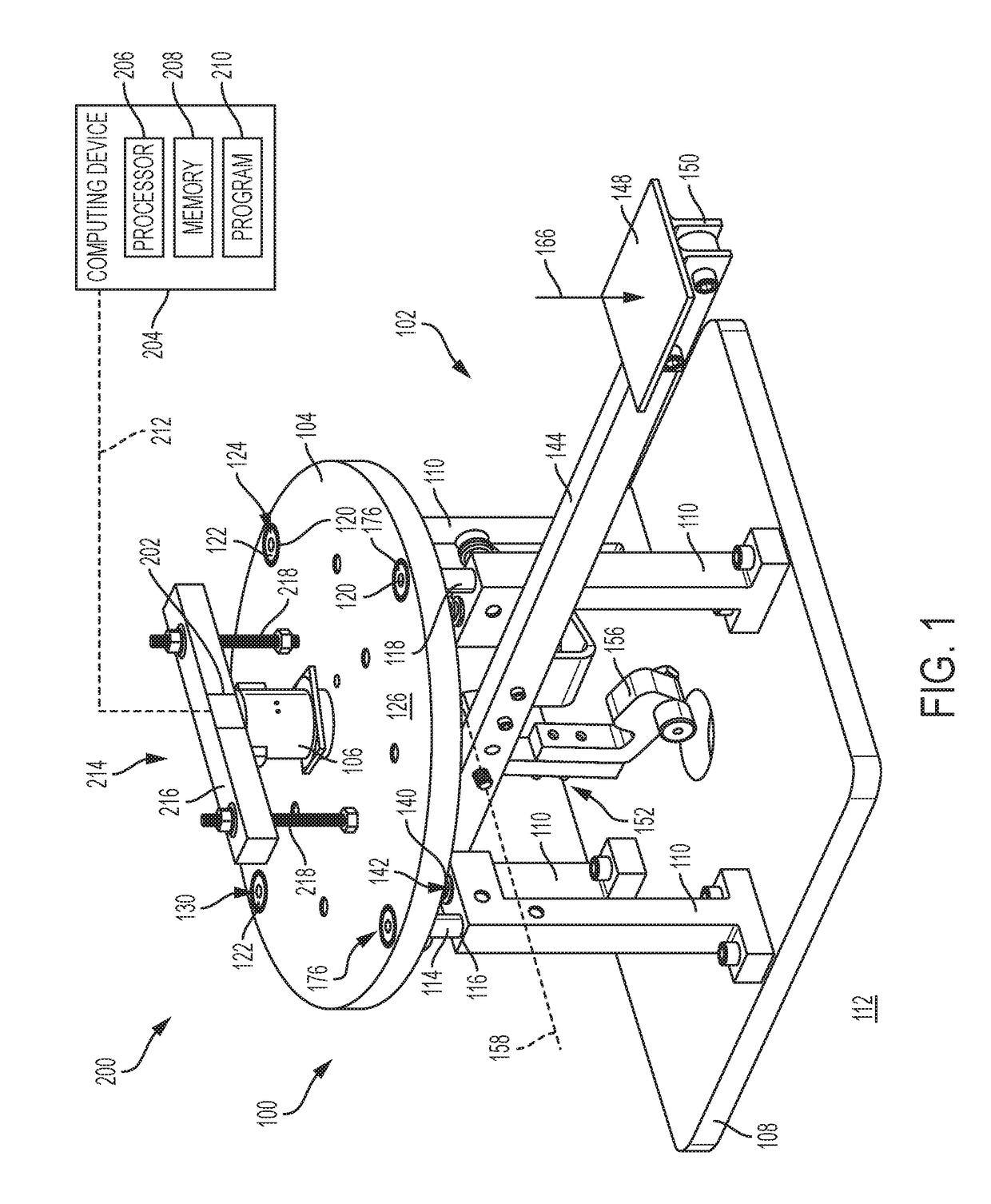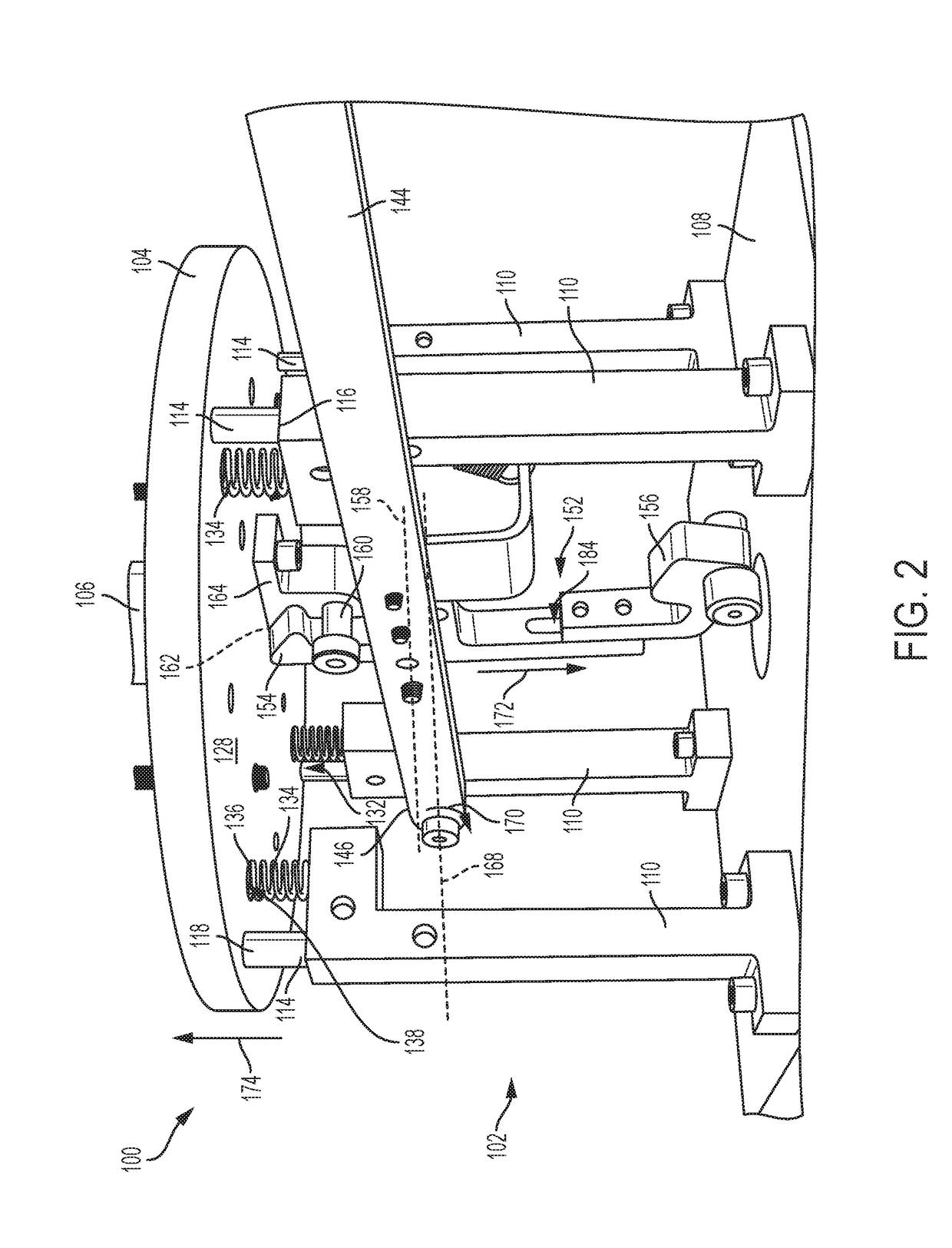Tunable mass damper characterization test stand
a technology of damper and characterization, which is applied in the direction of vibration testing, structural/machine measurement, measurement devices, etc., can solve the problems of increasing the chance of scale effects in the wind tunnel data, introducing experimental artifacts, and affecting any efforts
- Summary
- Abstract
- Description
- Claims
- Application Information
AI Technical Summary
Benefits of technology
Problems solved by technology
Method used
Image
Examples
example 1
[0033]This example describes an illustrative test stand for characterization of a tunable mass damper; see FIGS. 1-5.
[0034]FIG. 1 is an upper trimetric view of an illustrative embodiment of a test stand for characterization of a tunable mass damper, the test stand generally indicated at 100. FIG. 2 is a lower perspective view of test stand 100. FIGS. 1 and 2 are herein described together. Test stand 100 includes a support base 102 and a test plate 104 coupled to the support base. The test plate is configured to move relative to the support base and to fixedly carry a tunable mass damper (TMD) 106.
[0035]Support base 102 may include a base plate 108 and a plurality of support legs 110 coupled to the base plate. Base plate 108 may be configured to be supported on a work surface 112 such as a table, a desk, or a floor. In some examples, base plate 108 may be secured to the work surface by a clamp, bolts, or some other appropriate fastener. In some examples, base plate 108 may rest on wo...
example 2
[0073]This example describes an illustrative method of characterizing the oscillation properties of a tunable mass damper, which may be used in conjunction with any of the apparatuses or systems described herein; see FIG. 6.
[0074]FIG. 6 depicts multiple steps of a method, generally indicated at 300 of characterizing the oscillation properties of a tunable mass damper. Method 300 may be used in conjunction with any of the test stands depicted in and described in reference to FIGS. 1-5 and 8. Although various steps of method 300 are described below and depicted in FIG. 6, the steps need not necessarily all be performed, in some cases may be performed in a different order than the order shown, in some cases may be performed more than once, and in some cases may be performed simultaneously.
[0075]Method 300 may include a step 302 of mounting a tunable mass damper (TMD) to a test plate, the test plate being biased away from a support base by a spring. In some examples, mounting a TMD to a...
example 3
[0090]This examples describes an illustrative computing device; see FIG. 7.
[0091]As shown in FIG. 7, this example describes a data processing system 400 in accordance with aspects of the present disclosure. In this example, data processing system 400 is an illustrative data processing system suitable for implementing aspects of a system for testing a tunable mass damper. More specifically, in some examples, devices that are embodiments of data processing systems (e.g., smartphones, tablets, personal computers, oscilloscopes) may receive data from a detector, the data relating to the oscillation properties or characteristics of a tunable mass damper. The devices that are embodiments of data processing systems may identify or help to identify one or more oscillation characteristics of the tunable mass damper from the received data.
[0092]In this illustrative example, data processing system 400 includes communications framework 402. Communications framework 402 provides communications b...
PUM
 Login to View More
Login to View More Abstract
Description
Claims
Application Information
 Login to View More
Login to View More - R&D
- Intellectual Property
- Life Sciences
- Materials
- Tech Scout
- Unparalleled Data Quality
- Higher Quality Content
- 60% Fewer Hallucinations
Browse by: Latest US Patents, China's latest patents, Technical Efficacy Thesaurus, Application Domain, Technology Topic, Popular Technical Reports.
© 2025 PatSnap. All rights reserved.Legal|Privacy policy|Modern Slavery Act Transparency Statement|Sitemap|About US| Contact US: help@patsnap.com



